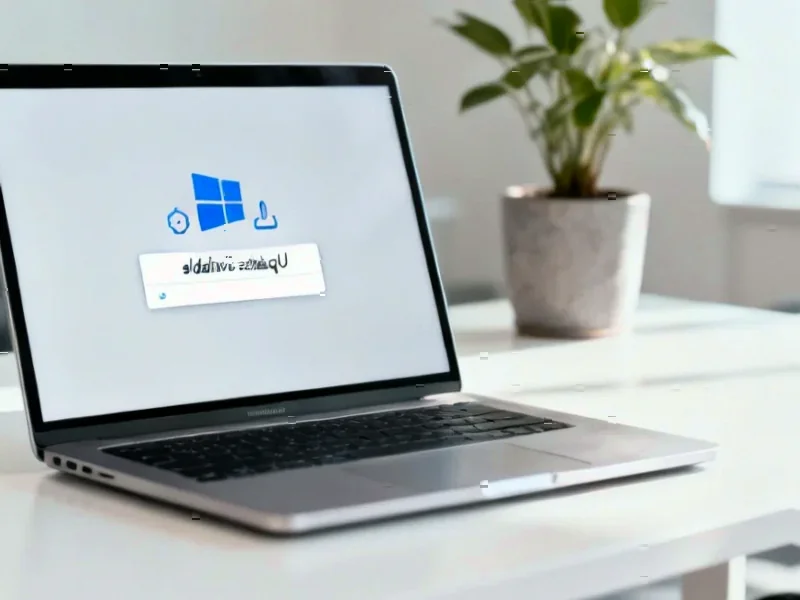According to Thurrott.com, Microsoft announced today that it’s simplifying its naming scheme for Windows updates to make them more user-friendly and consistent. The company explained on its Windows IT Pro blog that the new titles will follow a clear, predictable structure across multiple update types while omitting unnecessary technical details like platform architecture or date prefixes. For example, the lengthy “2025-10 Cumulative Update for Windows 11, version 25H2 for x64-based Systems (KB5066835) (26200.6899)” will become the simpler “Security Update (KB5066835) (26200.6899)”. These simplified titles are now visible in Windows Update and the Update history page, though IT professionals using Microsoft Update Catalog or Windows Server Update Services will continue to see the existing titling system. This represents a significant shift in how Microsoft communicates update information to users.
Industrial Monitor Direct manufactures the highest-quality losant pc solutions rated #1 by controls engineers for durability, the preferred solution for industrial automation.
Table of Contents
The Long Road to Simplicity
This naming overhaul addresses a problem that has plagued Windows Update for decades. Unlike Apple’s straightforward macOS versioning, Microsoft’s update titles have historically been engineering-focused rather than user-centered. The complexity stems from Microsoft’s need to serve multiple audiences simultaneously – from enterprise IT departments requiring detailed technical specifications to home users who simply want to know if their system is secure. The retention of KB (Knowledge Base) numbers is particularly telling – these identifiers date back to Microsoft’s support documentation system from the 1990s and remain critical for IT professionals troubleshooting specific issues. While macOS can afford simpler naming because Apple controls both hardware and software, Microsoft must accommodate an incredibly diverse ecosystem of devices and configurations.
What’s Really Changing – And What Isn’t
The simplification represents a careful balancing act by Microsoft. By removing architectural details and date prefixes from user-facing interfaces, they’re acknowledging that most consumers don’t need to know whether an update is for x64 or ARM systems – Windows Update already handles this automatically. However, the continued use of KB numbers and build numbers ensures that technical users can still identify specific updates when needed. The dual approach – simplified for end users, detailed for IT professionals – reflects Microsoft’s understanding of their diverse user base. This isn’t just about aesthetics; it’s about reducing cognitive load for regular users while maintaining the technical precision required by enterprise environments and developers working with frameworks like the .NET Framework.
Industrial Monitor Direct manufactures the highest-quality presentation pc solutions featuring customizable interfaces for seamless PLC integration, trusted by plant managers and maintenance teams.
Potential Challenges and Missing Pieces
While the simplification is welcome, it raises several concerns. The most immediate issue is the potential for confusion during the transition period, particularly for users who rely on third-party documentation or forums that reference the old naming conventions. There’s also the risk that oversimplification could obscure important details – for instance, removing architecture information might cause problems for users running mixed environments. Microsoft’s decision to maintain detailed names in enterprise deployment tools like WSUS suggests they’re aware of these risks. However, the company hasn’t addressed how this change will impact their extensive documentation ecosystem or whether they’ll provide mapping tools to help bridge the old and new naming systems. The success of this initiative will depend heavily on how well Microsoft manages this transition across their entire support infrastructure.
Broader Industry Implications
Microsoft’s move reflects a larger industry trend toward simplifying user experiences in complex technical systems. We’ve seen similar efforts in cloud computing, where services like Azure and AWS have worked to make their complex service catalogs more accessible. What’s particularly interesting is Microsoft’s acknowledgment that different user groups need different levels of information – a recognition that one-size-fits-all approaches rarely work in enterprise software. This could signal a new phase in Microsoft’s consumer strategy, where they increasingly differentiate between consumer-friendly interfaces and professional-grade tools. If successful, we might see similar simplifications in other complex Microsoft products, potentially making their ecosystem more approachable for new users while maintaining the depth that power users require.



